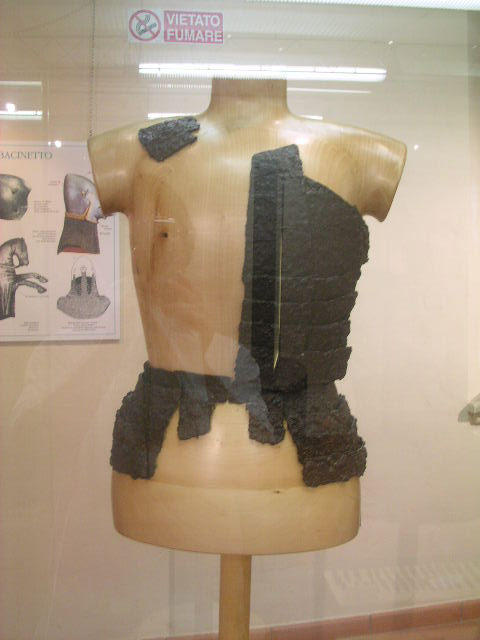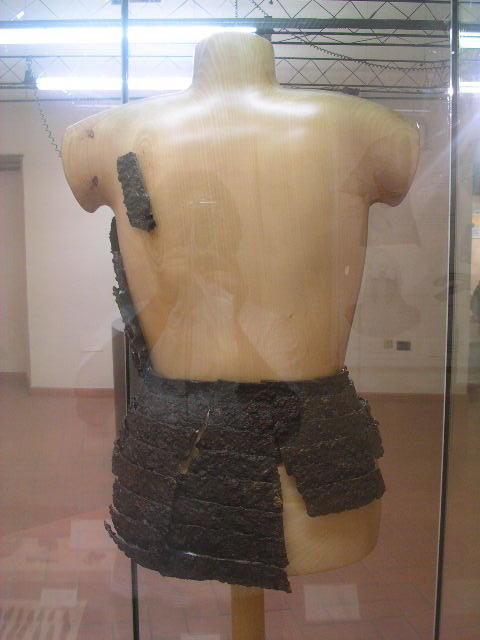Hello
I've found pics of this strange armour.It looks almost like brigandine.Almost-it has mail+large plate of steel inside,not little plates plates.There are two possible datings:
1.late 14century
2.late 15century
100 years difference.
Any thoughts?
http://www.fotosik.pl/showFullSize.php?id=73e1139f17e8467c
http://www.fotosik.pl/showFullSize.php?id=39a5ef0881a07ca1
http://www.fotosik.pl/showFullSize.php?id=d11beb07bb91f7b3
I have seen this before. I am not sure but I think it's late 15th.
It's been a long time from when I was doing research on an A&S project on Gambesons and I kept running into such examples.
Sometime the breast plate was in 2 halves and others in a single plate with small and medium plates around it. Did not see any with this amount of chain though.
It look like a peasant levy construct of what ever he could find on the battle field and put together. Free Companies did this as well.
I have no definitive proof or examples, and that research is long gone, so take it with a gain of salt and go from there.
It's been a long time from when I was doing research on an A&S project on Gambesons and I kept running into such examples.
Sometime the breast plate was in 2 halves and others in a single plate with small and medium plates around it. Did not see any with this amount of chain though.
It look like a peasant levy construct of what ever he could find on the battle field and put together. Free Companies did this as well.
I have no definitive proof or examples, and that research is long gone, so take it with a gain of salt and go from there.
I've seen similar pieces referred to under the name "transitional" before. I'm not sure if that one would fit whatever passed for a mold with that type, though.
http://guerriers-du-moyen-age.aceboard.fr/p-1...m#id369259
It is written in a book, that this brigantine 1380-1410 years, but I think that this brigantine of the late 15th.
It is written in a book, that this brigantine 1380-1410 years, but I think that this brigantine of the late 15th.
If you compare this brigandine/coat of plate with the following artworks dating from around 1380, it could date from late 14th century.
The soldiers standing on the right
http://www.wga.hu/art/a/altichie/st_james.jpg
http://www.wga.hu/art/a/altichie/beheadin.jpg
Both frescos have been painted by Altichiero da Zevio ( ca.1330 - ca. 1390).
Unfortunately I couldn't find a bigger picture on the web of the fresco of the first link. You can see details of it in the Osprey book, Italian Militiaman 1260-1392, Warrior Series by David Nicolle.
The soldiers standing on the right
http://www.wga.hu/art/a/altichie/st_james.jpg
http://www.wga.hu/art/a/altichie/beheadin.jpg
Both frescos have been painted by Altichiero da Zevio ( ca.1330 - ca. 1390).
Unfortunately I couldn't find a bigger picture on the web of the fresco of the first link. You can see details of it in the Osprey book, Italian Militiaman 1260-1392, Warrior Series by David Nicolle.
My appologies for the thread necromancy, however, I have a certain interest in the brigandine in OP - does anyone knows if any new information about it's "pedigree" has become avaliable? If it is, indeed, dated as late 14th - early 15th century body armour, it woud provide a rather interesting option for a couple of sets of armour I have to make in near future, but so far it would appear, that aside from iconographic evidence that seems to indicate something similar might have existed, we have rather little evidence to proove it is apropriate for such an early date.
There was a long and detailed discussion of that artifact that pretty much dismissed the museum dating as a misprint or typo. It almost certainly dates from a century later based on plate shape, rivet patterns and interior mail reinforcement. If one looks carefully at the Altichero frescoes, the differences are readily apparent. Earlier breastplates were much larger in corraza than the later brigandine assemblies. The faulds are quite different as well. The little fabric wings along the bottom edge are the kickers. They weren't seen in civilian fashion until a century after the presumed date - then they are ubiquitous.
Hello,
this could certainly help:
http://www.museodellacaccia.it/record.php?cod=Bd012922
it's an Italian brigandine exhibited in a small but interesting museum in the surroundings of Florence from the last quarter of the XV century, just the back part, not the entire as yours.
this could certainly help:
http://www.museodellacaccia.it/record.php?cod=Bd012922
it's an Italian brigandine exhibited in a small but interesting museum in the surroundings of Florence from the last quarter of the XV century, just the back part, not the entire as yours.
Well, I am more interessed in the armour at the turning for the 14th century to 15th at this point - have two sets to make and I would like to use a brigandine, but it would appear that the choice is to make a variation of Chalcis brigandine or try to compile something like St. Georges statue in Prague from the remains of armour found in Otepaa castle... hence I was looking for another options.
I hope that I do not derail this post, but here are two images of a suit that I have no providence for. My guesstimate is that it is 15th Century but wishful thinking and the bascinets in the background have me hoping they are late 14th Century. Does anyone have more information on this suit or clues where the information may be obtained?
Mackenzie
 Attachment: 41.84 KB
Attachment: 41.84 KB

 Attachment: 41.66 KB
Attachment: 41.66 KB

Mackenzie


This is the damaged suit that has been put togeather in a way that is questioned by scholars - it comes from the Livorno area. It is usually considered to be late 14th century, but, sadly, the reconstruction is questionable.
The coat of plates in the original links in this thread is in the Sforza Museum in Milan. IIRC it's ~1400
Cole
Cole
Here are some more images of the brig posted by Mackenzie. http://www.tforum.info/forum/index.php?showtopic=28075 I noticed that the brig posted by Gabriele has the waist plates overlapping the upper and lower plates on the outside, which means no dishing of the waist plates.
Pictures are taken by Toby Capwell and it's from Sforza, Italy. Dating ca 1380's if memory serves correctly.
Page 1 of 1
You cannot post new topics in this forumYou cannot reply to topics in this forum
You cannot edit your posts in this forum
You cannot delete your posts in this forum
You cannot vote in polls in this forum
You cannot attach files in this forum
You can download files in this forum
All contents © Copyright 2003-2006 myArmoury.com — All rights reserved
Discussion forums powered by phpBB © The phpBB Group
Switch to the Full-featured Version of the forum
Discussion forums powered by phpBB © The phpBB Group
Switch to the Full-featured Version of the forum